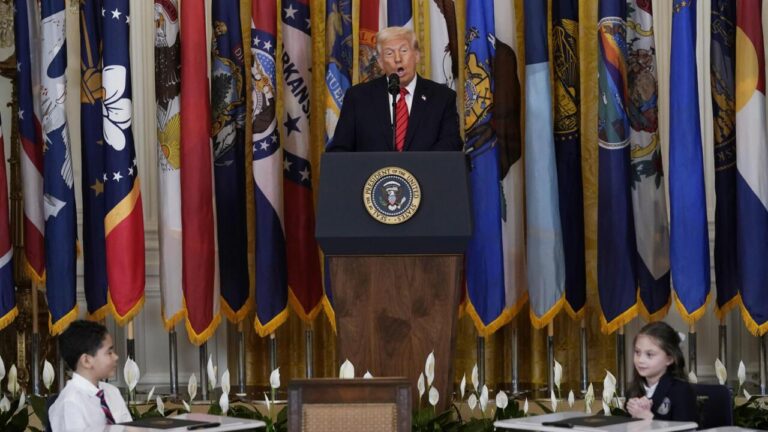Trump’s Demand to Dissolve the Education Department Ignites National Controversy
Former President Donald Trump has once again stirred political controversy by urging the immediate disbandment of the U.S. Department of Education. He argues that the federal agency has overstepped its bounds, failing both students and taxpayers, and insists that education governance should be returned to state and local authorities. This proposal intensifies the ongoing debate about the federal government’s role in education, drawing sharp reactions from policymakers, educators, and advocacy groups nationwide.
Trump’s stance challenges the current federal framework, which administers billions in education funding and student aid. His critics warn that such a move could destabilize critical programs, while supporters applaud the push for reduced federal interference and increased local autonomy. The polarized responses underscore the complexity of dismantling a department integral to the nation’s education system.
Below is a summary of the main arguments from both proponents and opponents of the closure:
| Arguments Supporting Closure | Arguments Against Closure |
|---|---|
| Limit federal intrusion in education decisions | Endanger stability of nationwide student aid programs |
| Reduce government expenditure on administrative overhead | Compromise equity for marginalized and low-income students |
| Promote innovation through local control | Weaken protections for students and educational institutions |
- Short-term disruptions could affect federal student loan processing and grant distribution.
- Long-term consequences for curriculum standards and accountability remain unpredictable.
- Political ramifications may influence upcoming elections and education policy debates.
Consequences of Department Closure on Federal Education Funding and Student Support
Eliminating the Department of Education would trigger immediate and profound effects on federal funding streams essential to public schools, colleges, and universities across the country. Annually, billions of dollars are allocated to programs such as Title I grants aimed at supporting disadvantaged students, the Individuals with Disabilities Education Act (IDEA) funding for special education, and Pell Grants that assist low-income college students. The dismantling of the federal infrastructure responsible for equitable resource distribution, compliance oversight, and accountability would leave many states scrambling to fill funding voids and maintain educational access.
Critical areas vulnerable to disruption include:
- Administration of federal student aid, risking interruptions in loan disbursements and repayments.
- Support services for students with disabilities, threatening the continuity of individualized education plans.
- Collection and analysis of education data vital for policy development and improvement.
| Program | Annual Federal Funding | Potential Consequences |
|---|---|---|
| Title I Grants | $16 Billion (2024 estimate) | Severe reductions impacting low-income communities |
| Special Education (IDEA) | $14 Billion | Loss of critical support services for disabled students |
| Pell Grants | $32 Billion | Decreased college affordability for economically disadvantaged students |
Education Experts Highlight Risks of Abrupt Department Shutdown
Prominent education researchers and policy experts have expressed serious concerns about the ramifications of an immediate closure of the Department of Education. They warn that such a drastic action could unravel years of progress in promoting educational equity, funding under-resourced schools, and maintaining federal oversight that ensures consistent standards nationwide.
Primary issues raised include:
- Interruption of financial aid distribution, affecting millions of college students’ ability to pay tuition.
- Disruption of federally mandated special education services, risking non-compliance with legal requirements.
- Suspension of national programs aimed at improving literacy rates and STEM education outcomes.
| Sector Affected | Likely Impact | Estimated Duration |
|---|---|---|
| Federal Student Aid | Delays in processing grants and loans | Immediate to 3 months |
| Special Education Services | Reduced oversight and compliance enforcement | 1 to 6 months |
| National Education Programs | Temporary suspension or scaling back | Indefinite uncertainty |
Strategic Recommendations for Legislators Amid Department Closure Proposal
Given the potential upheaval caused by the proposed immediate shutdown of the Department of Education, it is imperative that lawmakers proceed with caution. To safeguard the stability of the education system, protecting student services and institutional funding during any transition is paramount. Establishing a temporary oversight committee tasked with evaluating the impact on educational equity, access, and quality would provide essential, data-driven guidance to policymakers.
Moreover, fostering collaboration with educators, school leaders, parents, and other stakeholders is crucial to crafting resilient policies that support innovation and reform despite structural changes. Recommended actions include:
- Creating emergency funding provisions to help schools adapt to sudden administrative changes.
- Improving transparency and communication channels among federal, state, and local education authorities.
- Conducting a thorough review of how responsibilities will be redistributed to avoid service interruptions.
| Recommendation | Purpose | Anticipated Result |
|---|---|---|
| Temporary Oversight Committee | Assess impact comprehensively | Informed, evidence-based policymaking |
| Emergency Funding Mechanisms | Ensure financial continuity | Uninterrupted educational services |
| Stakeholder Engagement | Inclusive decision-making | Adaptive and responsive reforms |
Conclusion: The Future of Federal Education Policy Hangs in the Balance
As former President Donald Trump’s call to dismantle the Department of Education reverberates through political and educational circles, the debate over federal involvement in education is set to intensify. Stakeholders from all sides continue to evaluate the potential consequences for funding, policy, and governance. Ongoing coverage will track responses from government officials, educators, and advocacy groups as this significant story develops.







